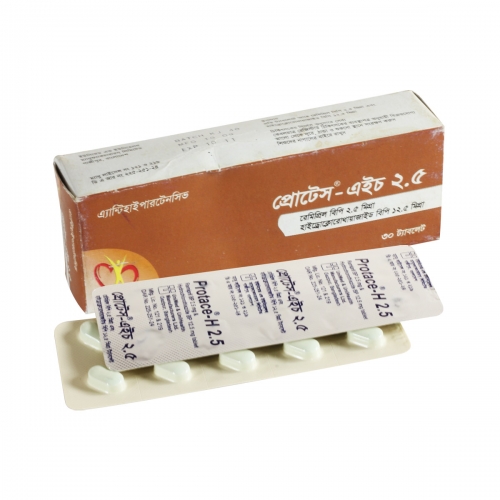ঔষধের বিস্তারিত বা বিকল্প ঔষধ জানতে ঔষধের নাম দিয়ে সার্চ দিন। যেমন- Napa বা Alatrol বা Amodis
Protace-H 2.5mg+12.5mg
TabletRamipril + Hydrochlorothiazide
Unimed Unihealth MFG. Ltd
Other Strength:
Alternative:

Protace-H
Presentation
Protace-H 2.5 tablet: Blue, capsule shaped, film coated tablet; each tablet contains Ramipril BP 2.5 mg and Hydrochlorothiazide BP 12.5 mg.
Indications
Indicated for the treatment of mild to moderate hypertension in patients (in whom combination therapy is appropriate) who have been stabilised on the individual components given in the same proportion.
Dosage and administration
Hypertension: The recommended initial dosage is 1 tablet of Protace-H 2.5 (Ramipril 2.5 mg and Hydrochlorothiazide 12.5 mg) once a day. The dose can be up titrated at intervals of 2-3 weeks to Ramipril 5 mg and Hydrochlorothiazide 12.5 mg tablet and then to a maximum of Ramipril 10 mg and Hydrochlorothiazide 12.5 mg. If required another antihypertensive agent may be added. In patients pre-treated with a diuretic, consideration must be given to discontinuing the diuretic at least 2-3 days (depending on the duration of action of the diuretic) longer before initiating the treatment with Ramipril 2.5 mg and Hydrochlorothiazide 12.5 mg (Protace-H 2.5). If discontinuation is not possible the treatment should be initiated with the smallest possible dose of Ramipril (1.25 mg daily) in a free combination.
Dosage in patients with impaired renal function: For patients with creatinine clearance between 60 and 30ml/min/1.73m2 body surface area, treatment is initiated with ramipril alone 1.25mg. After gradually increasing the dose of ramipril, medication with Ramipril 2.5 mg and Hydrochlorothiazide 12.5 mg (Protace- H 2.5) is initiated at a daily dose of 1 tablet. The maximum permitted daily dose is 2 tablets of Protace- H 2.5 mg in such patients.
Contra-indications, warnings, etc.
Contra-indication: Ramipril & Hydrochlorothiazide combination is contraindicated in patients with hypersensitivity to Ramipril (including angioedema) and Hydrochlorothiazide and in known or suspected renovascular disease. Ramipril should not be used in pregnancy
Warnings: Ramipril should not be used in patients with aortic or mitral valve stenosis or outflow obstruciton.
Use in pregnancy and lactation: Pregnancy should be excluded before start of treatment with ramipril and avoided during treatment; exposure of the mother to ACE inhibitors in mid or late pregnancy has been associated with oligohydramnios and neonatal hypotension with anuria or renal failure. From animal experiments it is know that use of ramipril may cause a decreased utero-placental perfusion. There is also a potential risk of fetal or postnatal effect as ACE inhibitors also influence the local renin-angiotensin system. In peri-post natal studies increased renal pelvic dilatation was observed in the first generation offspring. However, ramipril was not fetotoxic in studies althoug ACE inhibitors have shown fetotoxicity in some species. Ramipril should not be used during lactation.
Side effects: Ramipril can cause profound hypotension and renal impairment and a persistent dry cough. It may also cause angioedema (onset may be delayed), rash (which may be associated with pouritus and urticaria), pancreatitis and upper respiratory-tract symptoms such as sinusitis, and rhinitis. Gastro-intestinal effects reported with ACE inhibitors include nausea, vomiting. dyspepsia, diarrhoea and constipation. Altered liver function tests, cholestatic jaundice and hepatitis have been reported.Blood disorders including thronbocytopenia, leucopenia, neutropenia and haemolytic anaemia have also been reported. Other reported side-effects include headache, dizziness, fatigue, taste disturbance, bronchospasm, fever, and photosensitivity. Hydrochlorothiazide can cause tachycardia, serum sickness, weight loss, maculopapular rash, photosensitivity, flushing and acidosis.
Drug interactions: Combination with diuretics or other antihypertensive agents or nitrates and tricyclic antidepressants may potentiate the antihypertensive response to Ramipril and Hydrochlorothiazide. Adrenergic-blocking drugs should only be combined with ramipril under careful supervision. Potassium sparing diuretics (spironolactone, amiloride, triameterene) or potassium supplements may increase the risk of hyperkalaemia. Ramipril may attenuate the potassium loss caused by thiazide-type diuretics. If concomitant use of these agents is indicated, they should be given with caution and serum potassium should be monitored regularly. When antidiabetic agents (insulin and
sulphonylurea derivatives) are used concurrently, the possibility of increased blood-sugar reduction must be considered. If ramipril is given with lithium, an increase in serum lithium concentration may occur. When ACE inhibitors are administered simultaneously with non-steroidal anti-inflammatory drugs (e.g. acetylsalicylic acid and indomethacin), attenuation of the antihypertensive effect may occur.
Pharmaceutical precautions
Store in a cool and dry place, protected from light.
Package quantities
Protace-H 2.5 tablet: Cartons containing 30 tablets in blisters.
এই পাতাটি ১৮৯ বার দেখা হয়েছে
রাজডক কী?
ফ্রী সদস্য হোন Click Here
ডাক্তার হিসাবে যোগদান করতে Click Here
নার্স / টেকনোলজিস্ট হিসাবে যোগদান করতে Click Here
ফ্রী সদস্য হোন Click Here
ডাক্তার হিসাবে যোগদান করতে Click Here
নার্স / টেকনোলজিস্ট হিসাবে যোগদান করতে Click Here

